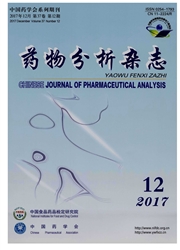

 中文摘要:
中文摘要:
目的:比较乌头母根(生川乌)与子根(生附片)化学成分的差异,为阐明川乌与附子功效不同的科学内涵提供依据。方法:采用超高效液相色谱-质谱联用技术(UPLC-MS),静电场轨道阱组合式高分辨质谱仪,ACQUITY UPLC BEH C_(18)色谱柱(150 mm×2.1 mm,1.7μm),以乙腈-0.1%甲酸为流动相,梯度洗脱,质谱在正离子模式下进行检测。结果:生川乌中指认65个成分,生附片中指认60个成分,其中两者共有成分56个,生川乌具有黄草乌碱丁、10-羟基焦乌头碱、印乌头碱等9个特有成分,生附片具有10-羟基焦乌头原碱、14-苯甲酰尼奥灵等4个特有成分。结论:乌头的母根(生川乌)与子根(生附片)的化学成分存在较大差异,该差异可能与川乌和附子的功效不同有关。
 英文摘要:
英文摘要:
Objective: To compare the differences of components in parent root and daughter root of Aconitum carmichaeli, so as to provide scientific evidence for interpreting different effects of Aconiti Radix and Aconiti Lateralis Radix. Methods: UPLC-MS analysis was performed on an Orbitrap modular high resolution mass spectrometer( LTQ-Orbitrap ), with Waters ACQU1TY UPLC BEH C18 column ( 150 mm× 2. 1 mm, 1.7 μm ) eluted with acetonitrile and 0. 1% formic acid in a gradient program, and the MS method was conducted in the positive ion mode. Results: 65 components were identified in unprocessed Aconiti Lateralis Radix and 60 components were identified in unprocessed Aconiti Lateralis Radix with 56 components in common. 9 specific components were detected in unprocessed Aconiti Radix including sachaconitine, dehydrated 10-OH-aconitine and indaconitine, etc. And 4 specific components were detected in unprocessed Aconiti Lateralis Radix including dehydrated 10-OH-aconine and 14-benzoylneoline, etc. Conclusion: There were remarkable differences between chemical components in parent root and daughter root of Aconitum carmichaeli, which might be related to the different efficacy of Aconiti Radix and Aconiti Lateralis Radix.
 同期刊论文项目
同期刊论文项目
 同项目期刊论文
同项目期刊论文
 期刊信息
期刊信息
